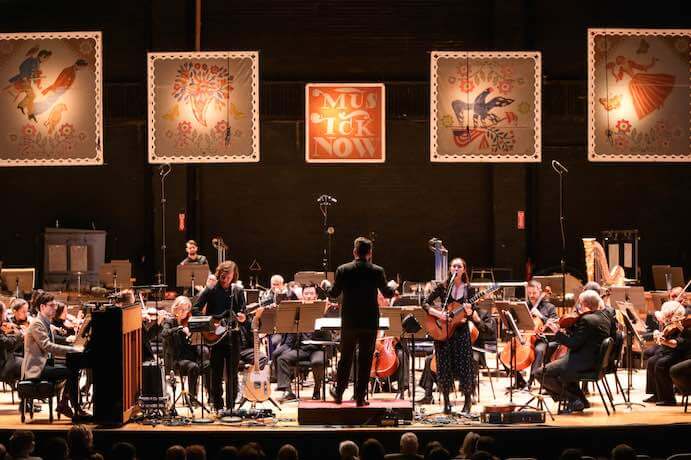“A symphony must be like the world. It must embrace everything.” Musical America’s 2017 Composer of the Year Andrew Norman invoked Mahler as he introduced his orchestral work Play to a refreshingly-mixed demographic audience at Cincinnati’s Taft Theatre on Friday, January 13, 2017. Norman’s 2017 Grawemeyer Award winning work kicked off the second evening of the MusicNOW festival presented by the Cincinnati Symphony Orchestra. Founded in 2006 by Bryce Dessner, MusicNOW annually hosts a roster of genre-defying contemporary musicians, and this year’s line up featured Bob Weir of the Grateful Dead; composers Andrew Norman, Anna Thorvaldsdottir, György Ligeti, Timo Andres, and Bryce Dessner; composer/conductor Matthias Pintscher; violinist Pekka Kuusisto; and folk singer Lisa Hannigan.
Play, Norman’s most ambitious work to date, is a 47-minute work for orchestra in three movements: “Level 1,” “Level 2,” and “Level 3.” The movement titles are meant to reference the structure of video games—however, other meanings of the word “play” (i.e. playing an instrument; musicians playing with one another) were more effectively realized in both the performance and the composition itself. Norman stated that he wanted to “create a journey” with this composition, and the most perceptible thread throughout this journey was the exploration of timbre. “Level 1” begins with a loud, ricocheting thwack from the low strings which ushers in a klangfarbenmelodie of instrumental textures, including wild xylophone glissandi, woodwind twittering, brass swells and fanfares, and an array of string techniques ranging from scratchy sul ponticello to percussive Bartok pizzicato. “Level One” presents a dichotomy between busy, and at times, cacophonous full ensemble passages and lyrical passages featuring melding tone colors. Aural cohesion eventually emerges from the chaos with fleeting moments of groove, and visual cohesion took the form of string glissandi as the entire section moved in identical fluid gestures.
Andrew Norman–Photo by Jessa Anderson
“Level 2” is meant to start with another visually-striking element: that of an “almost inaudible groove” that is seen before it is truly heard. Unfortunately, this effect was marred by a slew of people arriving late and disrupting what would have been an intimate interaction between the physical and musical elements of performance. Norman continues to introduce new sounds throughout this movement including prepared piano and an effect produced by striking brass mouthpieces with the palm, which yielded a pitched yet percussive pop. “Level 2” ends with the entire ensemble coming to a halt, both musically and physically. Then, individual members of the orchestra are “unfrozen” by the conductor one-by-one. While this theatrical component of the performance was noticeable, greater commitment to absolute stillness from all members of the ensemble would have made this section more convincing.
“Level 3” is Andrew Norman a la Music in Circles: a textural groove in the strings accompanying lyrical woodwind and brass motives that gloriously build. From this climax, the piece delicately unravels into single tones passed back and forth across the orchestra over a bed of non-pitched air effects. The Cincinnati Symphony navigated this challenging work with both technical finesse and melodic sensitivity, and conductor Matthias Pintscher demonstrated an outstanding command of the score.
Pintscher is the music director of the Ensemble Intercontemporain—the Paris-based new music ensemble founded by Pierre Boulez—and he cites Hans Werner Henze and Helmut Lachenmann as compositional influences. His idyll for orchestra began as a solo piano piece that was written for a close friend and mentor, and upon the death of this friend, Pintscher expanded the piece into a full orchestral work, which includes a recomposed version of the original piano piece. Pintscher explained that he drew the orchestral material from the original solo piano work, yet even with this information, the connections were challenging to identify. His complex musical voice synthesizes many modernist German compositional trends—however, his idyll for orchestra came across as difficult to decipher, even by a trained listener.
Matthias Pintcher conducts the Cincinnati Symphony Orchestra
From an audience perspective, the work elicited questions regarding the effectiveness of a composition without program notes—how important is perceptible process? Can the comprehension of a piece become too dependent on program notes? Without the assistance of a program to explain the history and construct of the work, idyll for orchestra appears to be a solo piano work inexplicably encased in an orchestral composition—the lack of piano timbre in the opening does not prepare the listener for the extended cadenza about two-thirds of the way through. Additionally, the musical similarities between the piano and orchestral sections are not easily discernible, and these connections only begin to make sense in retrospect after hearing the solo piano passage.
After a brief intermission, the evening ended with one of the high points of the weekend: folk-singer Lisa Hannigan and guitarist Aaron Dessner performing arrangements from Hannigan’s album At Swim with the Cincinnati Symphony Orchestra. Bryce Dessner briefly spoke of his commitment to featuring folk music at every MusicNOW festival, and Hannigan’s intimate, enchanting voice accompanied by Aaron Dessner on guitar and Timo Andres on piano was the perfect send-off for the night. After a concert of thoughtfully-curated, laudably-performed, and well-received new music, it was easy to leave the theater sharing the same charming sentiment that Hannigan had whispered into the microphone between pieces: “I’m so happy.”

